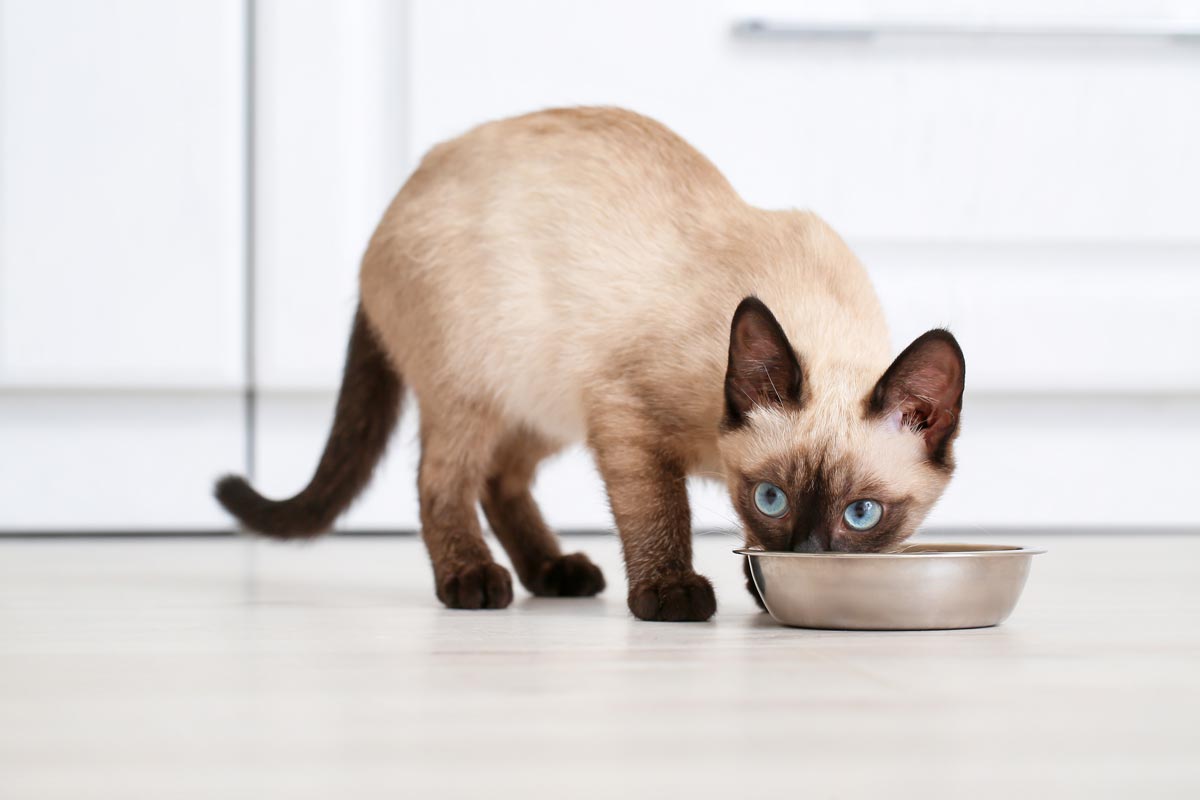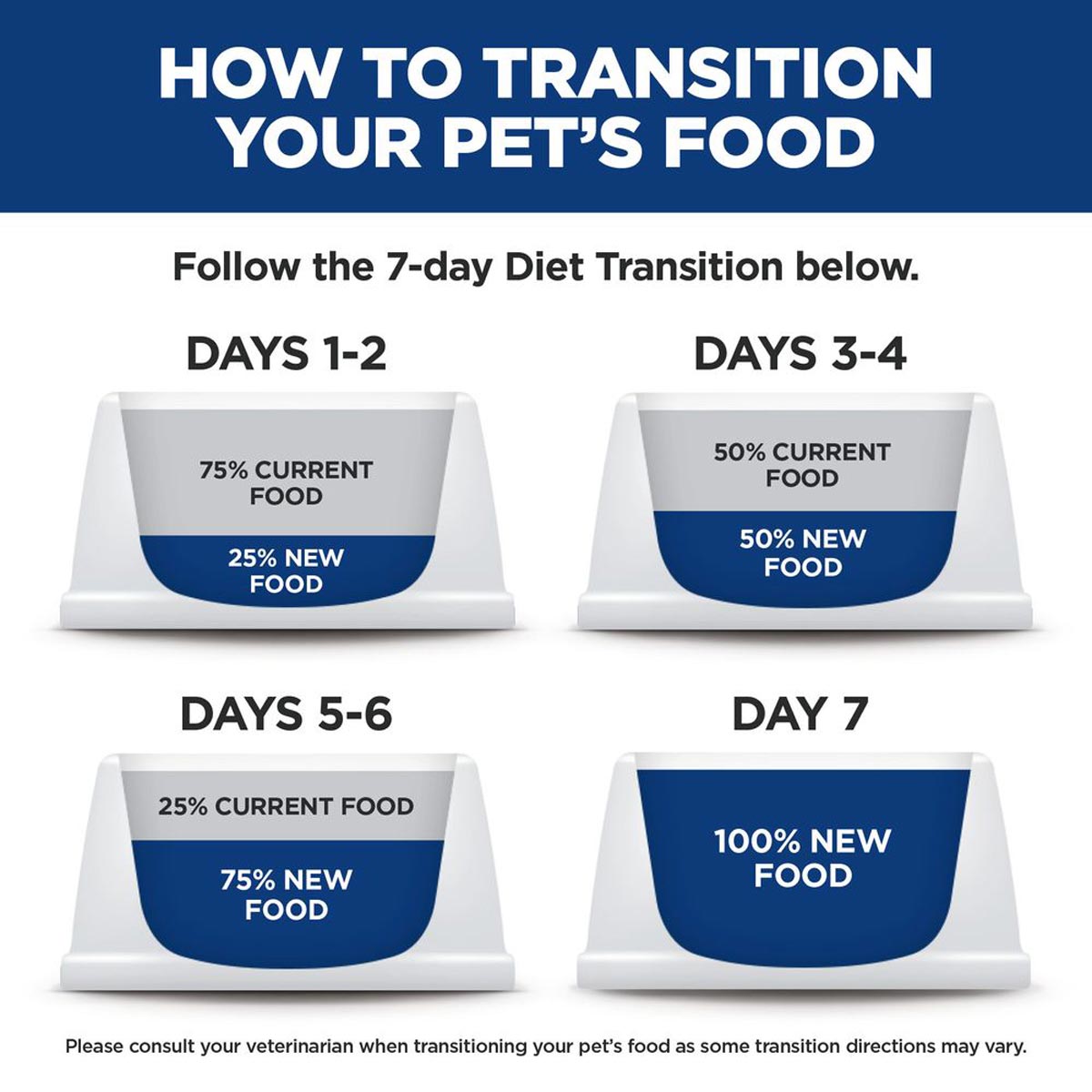Feeding puppies and kittens properly reduces their risk of becoming overweight and developing orthopedic and other diseases and helps set them up for a long and healthy life. Here are some guidelines to help you make healthy choices for the little furry addition to your family.
Choosing the Best Food
Puppies and kittens have specific nutritional needs during their first year of life (18 to 24 months in the case of certain giant breed puppies). They need the right balance of essential nutrients – protein, carbohydrates, vitamins, minerals, fats (including the omega fatty acid DHA), and antioxidants.
Too much, too little, or the absence of a specific nutrient can contribute to developmental and health problems. For example, the amino acid taurine found only in meat and fish is something kittens have to have in order to avoid heart disease and vision problems. Similarly, puppies and kittens that take in too many calories and too much calcium can develop orthopedic deformities.

Meanwhile, with so many brands and types of diets available to pet owners, it’s hard to know which to choose. The best food for your puppy or kitten is the one that’s complete and balanced and scientifically tested to meet the requirements for growth.

Doing Your Homework
Here are a few things you can do towards making an informed pet food choice.
- Look for an AAFCO nutritional adequacy statement on the packaging. AAFCO (the Association of American Feed Control Officials) is a private, non-profit organization that provides pet food regulators with ingredient definitions as well as label and laboratory standards. A food with an AAFCO statement such as “animal feeding tests using AAFCO procedures substantiate that [pet food X] provides complete and balanced nutrition for growth” is preferred. It means the food contains at least minimum levels of all necessary nutrients (and doesn’t exceed maximum levels) needed for the stated life stage (“growth” is for puppies and kittens) and that the food has been through at least a basic level of feeding trials to ensure that it meets dietary needs.Keep in mind that AAFCO itself doesn’t test, regulate, certify, or approve pet foods. Choosing a food with an AAFCO statement is just a place to start. If you want to be sure that a food has been manufactured with the appropriate nutritional expertise and quality controls in place, you’ll have to dig deeper. See the next point below.

- Follow the World Small Animal Veterinary Association (WSAVA) Global Nutrition Committee’s Guidelines on Selecting Pet Foods to help determine if a food is nutritious, of good quality, and safe to feed. Be wary of any pet food manufacturer that can’t or won’t provide the information outlined in these guidelines.
- Talk to your veterinary team for guidance. Diets that can be problematic for puppy and kitten development and health include raw, boutique, exotic, grain-free, home-cooked, and vegan diets, to name a few. If you’re considering any of these, it’s best to have a discussion with your veterinary team to understand their health implications. Nutrition is part of our training (food is medicine after all), and we’re here to help.
- Learn about common pitfalls of choosing a pet food. See “Avoiding Common Mistakes” below.
Avoiding Common Mistakes
Misinformation and misconceptions about pet foods abound. Here are a few to keep in mind:
- Misreading pet food labels. Many pet owners choose a food based on the ingredients list without realizing that that list doesn’t provide any information about the quality of the ingredients or whether they’re in the right proportion.

Meanwhile, a pet owner might avoid a pet food listing ‘by-products’ (carcass leftovers) without understanding that by-products typically contain more nutrients than muscle meat alone. By-products include organ meats (liver, kidney, and so on) and entrails – but not animal feet, hair, hides, and intestinal contents that some sources would have you believe. While many ingredients aren’t regulated by the petfood industry, by-products are, and regulations prohibit the inclusion of those carcass parts no one wants to feed their pet.
Another common misconception is the order in which ingredients are listed. We tend to think ingredients used in the greatest amounts are listed first, so pet owners often look for meat as the first ingredient. But pet food regulations require that ingredients are listed in order by weight and that weight includes water. So fresh meat which contains a lot of water (as much as 70%), tends to be listed first even though it may contribute fewer nutrients overall.

- Falling for marketing claims on packaging. Marketing often aims to appeal to you on an emotional level, not a rational one. It gives you “all the feels,” but not necessarily the facts. It’s important to know that claims such as “human grade,” “premium,” “holistic” and “natural” that sound appealing are just marketing. They have no legal definition in the pet food industry and don’t meet any specific nutritional requirements. Similarly, some ingredients (such as blueberries and kale) are listed for their marketing appeal but have no known nutritional benefits for a puppy or kitten and are probably just adding to the cost of the food.
- Being swayed by opinions and pet food ratings on the internet. The internet can be a great resource, but also a source of misinformation. Personal opinions and internet ratings are often not based on any scientific knowledge or real understanding of companion animal nutrition and how it affects health. It’s important to keep in mind that what works for one person’s pet may not be appropriate for yours for a variety of reasons. Your veterinary team can help you sort fact from fiction and make healthy choices for your pet.
- Expensive doesn’t necessarily mean ‘high quality’ and vice versa. The cost of a pet food may reflect the degree of nutritional expertise and testing that’s gone into the food, but it can also reflect inclusion of ingredients (some of which are unnecessary) that drive up the price.
Wet Food or Dry Food?
You can feed dry food (kibble) or wet food (canned) or a combination to your puppy or kitten. Dry food tends to be a less expensive and more convenient way to feed a pet, and it can help prevent tartar buildup. Compared to dry food, canned food contains more moisture (helpful when increased water intake is needed) and tends to be higher in protein and fat and lower in carbohydrates but can be cost prohibitive for large breed puppies.
For kittens, it’s important to feed at least some canned food because some adult cats won’t eat a type of food they weren’t offered as kittens. That can be a problem down the road if a cat develops health issues (e.g., lower urinary tract disease, kidney disease, diabetes, or obesity) that are better managed with a diet of canned food.

Transitioning to a New Food
Any change to a new diet should be made gradually over about one week. (Kittens may need a little longer to transition.) Feed a mixture of about 75% of the original diet with 25% of the new diet for a couple of days, then half and half of each for a couple of days, then 25% of the original with 75% of the new for a couple of days, then just the new food. This avoids tummy upset and helps encourage acceptance of the new food.

Feeding Amounts
How much you should feed your puppy or kitten depends on the food you’re feeding and will change over the course of his/her development. In general, you should start by following the guidelines on the packaging, keeping in mind that every pet is unique and may need more or less than the guidelines provided depending on your pet’s genetics, activity level, and other factors. The Pet Nutrition Alliance provides an online calorie calculator that can be helpful in determining the caloric needs in healthy pets with average activity levels. Don’t use it if your puppy or kitten is underweight or overweight or has a medical issue. Instead, consult your veterinary team.
Feeding Frequency
Puppies and kittens have greater demands for energy and nutrition but smaller stomachs than adults, so they need at least three separate meals over the course of the day until they’re about 6 months of age. More frequent feedings during those first 6 months also avoids bouts of low blood sugar that can be harmful. Take care not to feed more than your pet should be eating over the course of the day to avoid excessive weight gain. At about 6 months of age, you can switch to twice-daily feedings.
Adding Dietary Supplements
Once you’ve chosen an appropriate complete and balanced diet, no additional vitamin or mineral supplements should be given to avoid inadvertently feeding your pet excessive amounts of nutrients that could do more harm than good.

Giving Treats
Too many calories can cause a puppy or kitten to grow too quickly and become overweight, increasing their risk of developing bone and joint problems. (This is especially true in large and giant breed puppies.) Treats should make up no more than 10% of a pet’s total daily calories to avoid causing a nutritional imbalance and excessive weight gain. Avoid feeding table scraps as they tend to lead to weight gain/obesity and a picky appetite, which is problematic if a pet needs to be fed a special diet for a medical issue down the road. Keep in mind that you can use kibble from your pet’s daily allotment as a treat to avoid overfeeding.

Access to Water
Puppies and kittens should always have access to fresh water to ensure that they’re keeping well hydrated. Water lubricates tissues, regulates body temperature, keeps blood and lymphatic systems flowing, and facilitates a host of internal processes – and because puppies and kittens are growing and highly active, their need for water is greater than that of an adult. Water should never be withheld, even if your pet is having urinary accidents in the house. Without adequate water, puppies and kittens can get quite sick.

